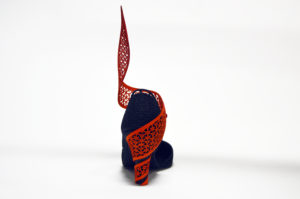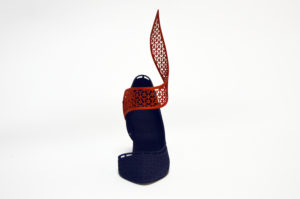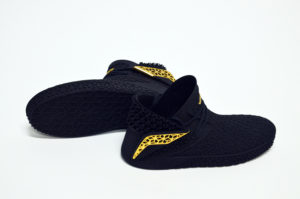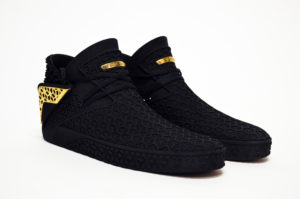 We’ve written quite a bit about 3D printed shoes lately. Yesterday, we learned that Cleveland Indians pitcher Corey Kluber was the first player to wear partially 3D printed cleats in a major league baseball game, and Wiivv recently launched a Kickstarter campaign (which is steadily approaching its fundraising goal) for custom 3D printed sandals. Around the same time, Under Armour released a new athletic shoe with a 3D printed midsole. 3D printing is definitely infiltrating the footwear industry, but the vast majority of “3D printed” shoes on the market are still mostly produced with conventional manufacturing techniques, including only partially 3D printed components such as soles or inserts.
We’ve written quite a bit about 3D printed shoes lately. Yesterday, we learned that Cleveland Indians pitcher Corey Kluber was the first player to wear partially 3D printed cleats in a major league baseball game, and Wiivv recently launched a Kickstarter campaign (which is steadily approaching its fundraising goal) for custom 3D printed sandals. Around the same time, Under Armour released a new athletic shoe with a 3D printed midsole. 3D printing is definitely infiltrating the footwear industry, but the vast majority of “3D printed” shoes on the market are still mostly produced with conventional manufacturing techniques, including only partially 3D printed components such as soles or inserts.
Industrial designer Amadou ba Ndiaye wanted to investigate 3D printing as a means of producing an entire shoe, not just part of it. In a project he calls “The Genesis Project,” the Montreal-based designer used 3D scanning and selective laser sintering (SLS) to design and 3D print two pairs of shoes – a flashy black and gold sneaker and an elegant pair of red and black high heels. 3DPrint.com spoke with ba Ndiaye recently about the project.
“For many reasons, the implementation of this new technology is more prevalent in the shoe industry sector,” he tells us. “In this era of technological development, the purpose of the Genesis Project was to explore the potential of 3D printing in this industry, and to demonstrate that it can be a reliable way to produce entirely a shoe and not just partially as it is the case nowadays for example with the Adidas Futurecraft 3D or the Under Armour Architech which to their credit, had more constraints to consider, due to their sport orientation, compared to the Genesis project.”
 TPU was used for the black sneaker, which was 3D printed entirely in one piece with the exception of the gold embellishment, which was manufactured using lost wax casting from a 3D printed mold. The gold part is removable and replaceable, ba Ndiaye says, so that wearers can customize their shoes to their liking. The high heeled shoes were 3D printed in TPU as well; however, the heels themselves were printed in PA 2200, as were the red ribbon-like embellishments that wrap around the heel and the wearer’s ankle.
TPU was used for the black sneaker, which was 3D printed entirely in one piece with the exception of the gold embellishment, which was manufactured using lost wax casting from a 3D printed mold. The gold part is removable and replaceable, ba Ndiaye says, so that wearers can customize their shoes to their liking. The high heeled shoes were 3D printed in TPU as well; however, the heels themselves were printed in PA 2200, as were the red ribbon-like embellishments that wrap around the heel and the wearer’s ankle.
“All the parts in TPU were made by materialise in Belgium, the same company that produced the 3d printed parts for the Adidas Futurecraft 3D,” ba Ndiaye tells 3DPrint.com. “Materialise is one of the rare company that propose TPU in their SLS machines…so I almost had no choice to choose them for the parts in TPU. The parts in PA 2200 were made by anubis 3D, a company in Ontario.”
He decided to go with SLS because, although it’s pricier than FDM, it offers a greater level of precision and detail, as well as durability. The goal of the project wasn’t just to produce a pair of entirely 3D printed shoes for the sake of proving that it could be done; ba Ndiaye also wanted to demonstrate the specific advantages that 3D printing offers over more traditional means of fabrication. Thus, he made sure to come up with complex, unusual designs that would be difficult to produce without 3D printing. In addition to design freedom, he also points out multiple other advantages of 3D printing for footwear production:
- Reduced design and development time
- Elimination of the need for molds
- More flexibility in the production process
- The ability to customize design and fit according to customers’ preferences and scan data
- Reduction of unnecessary inventory
Ba Ndiaye, a freelance designer, worked alone on this particular project, and at this point, he has no plans to commercialize the shoes he designed. That’s a shame in my opinion, because they’re gorgeous and also look wearable, which is still somewhat rare in 3D printed apparel. The designer won’t rule anything out completely, though.
“For now, there is no plan to commercialize those models, this project is just a proof of concept to demonstrate the potential of 3d printing in the shoe industry, but there are a lot of things going on in the 3d printing industry,” he tells us. “So who knows…”
You can learn more about ba Ndiaye’s past work by visiting his LinkedIn profile. Discuss in the 3D Printed Shoes forum at 3DPB.com.
[Images provided to 3DPrint.com by Amadou ba Ndiaye]
Subscribe to Our Email Newsletter
Stay up-to-date on all the latest news from the 3D printing industry and receive information and offers from third party vendors.
Print Services
Upload your 3D Models and get them printed quickly and efficiently.
You May Also Like
Making 3D Printing Personal: How Faraz Faruqi Is Rethinking Digital Design at MIT CSAIL
What if your 3D printer could think more like an intelligent assistant, able to reason through a design idea, ask questions, and deliver something that works exactly the way the...
Reinventing Reindustrialization: Why NAVWAR Project Manager Spencer Koroly Invented a Made-in-America 3D Printer
It has become virtually impossible to regularly follow additive manufacturing (AM) industry news and not stumble across the term “defense industrial base” (DIB), a concept encompassing all the many diverse...
Heating Up: 3D Systems’ Scott Green Discusses 3D Printing’s Potential in the Data Center Industry
The relentless rise of NVIDIA, the steadily increasing pledges of major private and public investments in national infrastructure projects around the world, and the general cultural obsession with AI have...
Formlabs Teams Up with DMG MORI in Japan
In late June, Nick Graham, Chief Revenue Officer at Formlabs, announced on LinkedIn that the company had partnered with DMG MORI, one of the world’s leading machine tool companies, to...






































